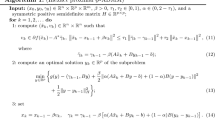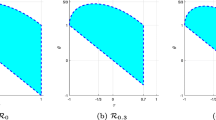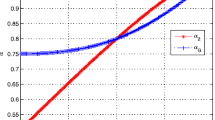Abstract
In this paper, we show that for a class of linearly constrained convex composite optimization problems, an (inexact) symmetric Gauss–Seidel based majorized multi-block proximal alternating direction method of multipliers (ADMM) is equivalent to an inexact proximal augmented Lagrangian method. This equivalence not only provides new perspectives for understanding some ADMM-type algorithms but also supplies meaningful guidelines on implementing them to achieve better computational efficiency. Even for the two-block case, a by-product of this equivalence is the convergence of the whole sequence generated by the classic ADMM with a step-length that exceeds the conventional upper bound of \((1+\sqrt{5})/2\), if one part of the objective is linear. This is exactly the problem setting in which the very first convergence analysis of ADMM was conducted by Gabay and Mercier (Comput Math Appl 2(1):17–40, 1976), but, even under notably stronger assumptions, only the convergence of the primal sequence was known. A collection of illustrative examples are provided to demonstrate the breadth of applications for which our results can be used. Numerical experiments on solving a large number of linear and convex quadratic semidefinite programming problems are conducted to illustrate how the theoretical results established here can lead to improvements on the corresponding practical implementations.


Similar content being viewed by others
Notes
This question was first resolved in [48] when the initial multiplier \(x^0\) satisfies \(\mathcal {G}x^0-b=0\) and all the subproblems are solved exactly.
This is equivalent to say that \(\mathcal {R}^{-1}\) is calm at \(0\in \mathbb {U}\) for \({\overline{u}}\in \mathbf {K}\) with the same modulus \(\kappa >0\), see [11, Theorem 3H.3].
This lemma can be directly verified via the singular value decomposition of the linear operator \(\mathcal {G}\) and some basic calculations from linear functional analysis.
This can be routinely derived by using the singular value decomposition of \(\mathcal {G}\) and the definition of the Moore–Penrose pseudoinverse.
References
Bai, M., Zhang, X., Ni, G., Cui, C.: An adaptive correction approach for tensor completion. SIAM J. Imaging Sci. 9, 1298–1323 (2016)
Bai, S., Qi, H.-D.: Tackling the flip ambiguity in wireless sensor network localization and beyond. Digit. Signal Process. 55, 85–97 (2016)
Bertsekas, D.P., Tsitsiklis, J.N.: Parallel and Distributed Computation: Numerical Methods. Athena Scientific, Belmont (1997)
Boyd, S., Parikh, N., Chu, E., Peleato, B., Eckstein, J.: Distributed optimization and statistical learning via the alternating direction method of multipliers. Found. Trends Mach. Learn 3, 1–122 (2011)
Chen, L., Sun, D.F., Toh, K.-C.: A note on the convergence of ADMM for linearly constrained convex optimization problems. Comput. Optim. Appl. 66, 327–343 (2017)
Chen, L., Sun, D.F., Toh, K.-C.: An effcient inexact symmetric Gauss-Seidel based majorized ADMM for high-dimensional convex composite conic programming. Math. Program. 161(1–2), 237–270 (2017)
Chen, S.S., Donoho, D.L., Saunders, M.A.: Atomic decomposition by basis pursuit. SIAM Rev. 43, 129–159 (2001)
Clarke, F.H.: Optimization and Nonsmooth Analysis. Wiley, New York (1983)
Ding, C., Qi, H.-D.: Convex optimization learning of faithful Euclidean distance representations in nonlinear dimensionality reduction. Math. Program. 164(1–2), 341–381 (2017)
Ding, C., Sun, D.F., Sun, J., Toh, K.-C.: Spectral operators of matrices. Math. Program. 168, 509–531 (2018)
Dontchev, A.L., Rockafellar, R.T.: Implicit Functions and Solution Mappings, 2nd edn. Springer, New York (2014)
Du, M.Y.: A two-phase augmented Lagrangian method for convex composite quadratic programming. Ph.D. thesis, Department of Mathematics, National University of Singapore (2015)
Eckstein, J.: Augmented Lagrangian and alternating direction methods for convex optimization: a tutorial and some illustrative computational results. RUTCOR Research Reports (2012)
Eckstein, J., Yao, W.: Understanding the convergence of the alternating direction method of multipliers: theoretical and computational perspectives. Pac. J. Optim. 11, 619–644 (2015)
Eisenblätter, A., Grötschel, M., Koster, A.: Frequency planning and ramification of coloring. Discuss. Math. Graph Theory 22, 51–88 (2002)
Fazel, M., Pong, T.K., Sun, D.F., Tseng, P.: Hankel matrix rank minimization with applications to system identification and realization. SIAM J. Matrix Anal. 34(3), 946–977 (2013)
Ferreira, J., Khoo, Y., Singer, A.: Semidefinite programming approach for the quadratic assignment problem with a sparse graph. Comput. Optim. Appl. 69(3), 677–712 (2018)
Gabay, D., Mercier, B.: A dual algorithm for the solution of nonlinear variational problems via finite element approximation. Comput. Math. Appl. 2(1), 17–40 (1976)
Gaines, B.R., Kim, J., Zhou, H.: Algorithms for fitting the constrained lasso. J. Comput. Graph. Stat. 27(4), 861–871 (2018)
Glowinski, R.: Lectures on Numerical Methods for Non-Linear Variational Problems. Bombay. Springer, Published for the Tata Institute of Fundamental Research (1980)
Glowinski, R., Marroco, A.: Sur l’approximation, par éléments finis d’ordre un, et la résolution, par pénalisation-dualité d’une classe de problèmes de Dirichlet non linéaires. Revue française d’atomatique, Informatique Recherche Opérationelle. Analyse Numérique 9(2), 41–76 (1975)
Han, D.R., Sun, D.R., Zhang, L.W.: Linear rate convergence of the alternating direction method of multipliers for convex composite programming. Math. Oper. Res. 43(2), 622–637 (2018)
Hestenes, M.: Multiplier and gradient methods. J. Optim. Theory Appl. 4(5), 303–320 (1969)
Huber, P.J.: Robust estimation of a location parameter. Ann. Math. Stat. 35, 73–101 (1964)
James, G.M., Paulson, C., Rusmevichientong, P.: Penalized and constrained optimization: an application to high-dimensional website advertising. J. Amer. Stat. Asso. (2019). https://doi.org/10.1080/01621459.2019.1609970
Klopp, O.: Noisy low-rank matrix completion with general sampling distribution. Bernoulli 20(1), 282–303 (2014)
Lam, X.Y., Marron, J.S., Sun, D.F., Toh, K.-C.: Fast algorithms for large scale generalized distance weighted discrimination. J. Comput. Graph. Stat. 27(2), 368–379 (2018)
Lemaréchal, C., Sagastizábal, C.: Practical aspects of the Moreau–Yosida regularization: theoretical preliminaries. SIAM J. Optim. 7(2), 367–385 (1997)
Li, M., Sun, D.F., Toh, K.-C.: A majorized ADMM with indefinite proximal terms for linearly constrained convex composite optimization. SIAM J. Optim. 26(2), 922–950 (2016)
Li, X.D., Sun, D.F., Toh, K.-C.: A Schur complement based semi-proximal ADMM for convex quadratic conic programming and extensions. Math. Program. 155, 333–373 (2016)
Li, X.D., Sun, D.F., Toh, K.-C.: QSDPNAL: a two-phase augmented Lagrangian method for convex quadratic semidefinite programming. Math. Program. Comput. 10(4), 703–743 (2018)
Li, X.D., Sun, D.F., Toh, K.-C.: A block symmetric Gauss-Seidel decomposition theorem for convex composite quadratic programming and its applications. Math. Program. 175, 395–418 (2019)
Liu, J., Musialski, P., Wonka, P., Ye, J.: Tensor completion for estimating missing values in visual data. IEEE Trans. Pattern Anal. Mach. Intell. 35, 208–220 (2013)
Malick, J., Povh, J., Rendl, F., Wiegele, A.: Regularization methods for semidefinite programming. SIAM J. Optim. 20, 336–356 (2009)
Mateos, G., Bazerque, J.-A., Giannakis, G.B.: Distributed sparse linear regression. IEEE Trans. Signal Proces. 58, 5262–5276 (2010)
Miao, W.M., Pan, S.H., Sun, D.F.: A rank-corrected procedure for matrix completion with fixed basis coefficients. Math. Program. 159, 289–338 (2016)
Negahban, S., Wainwright, M.J.: Restricted strong convexity and weighted matrix completion: optimal bounds with noise. J. Mach. Learn. Res. 13, 1665–1697 (2012)
Nie, J., Wang, L.: Regularization methods for SDP relaxations in large-scale polynomial optimization. SIAM J. Optim. 22, 408–428 (2012)
Nie, J., Wang, L.: Semidefinite relaxations for best rank-\(1\) tensor approximations. SIAM J. Matrix Anal. Appl. 35, 1155–1179 (2014)
Peng, J., Wei, Y.: Approximating k-means-type clustering via semidefinite programming. SIAM J. Optim. 18, 186–205 (2007)
Potra, F.A.: Weighted complementarity problems—a new paradigm for computing equilibria. SIAM J. Optim. 22, 1634–1654 (2012)
Powell, M.: A method for nonlinear constraints in minimization problems. In: Fletcher, R. (ed.) Optimization, pp. 283–298. Academic Press, New York (1969)
Povh, J., Rendl, F., Wiegele, A.: A boundary point method to solve semidefinite programs. Computing 78, 277–286 (2006)
Rockafellar, R.T.: Convex Analysis. Princeton University Press, Princeton (1970)
Rockafellar, R.T.: Augmented Lagrangians and applications of the proximal point algorithm in convex programming. Math. Oper. Res. 1, 97–116 (1976)
Schizas, I.D., Ribeiro, A., Giannakis, G.B.: Consensus in ad hoc WSNs with noisy links—part I: distributed estimation of deterministic signals. IEEE Trans. Signal Process. 56, 350–364 (2008)
Sloane, N.: Challenge problems: independent sets in graphs. https://oeis.org/A265032/a265032.html. Accessed 16 Aug 2019
Sun, D.F., Toh, K.-C., Yang, L.Q.: A convergent 3-block semi-proximal alternating direction method of multipliers for conic programming with 4-type constraints. SIAM J. Optim. 25(2), 882–915 (2015)
Teo, C.H., Vishwanathan, S.V.N., Smola, A., V.Le, Q.: Bundle methods for regularized risk minimization. J. Mach. Learn. Res. 11, 313–365 (2010)
Toh, K.-C.: Solving large scale semidefinite programs via an iterative solver on the augmented systems. SIAM J. Optim. 14, 670–698 (2004)
Toh, K.-C.: An inexact primal–dual path-following algorithm for convex quadratic SDP. Math. Program. 112(1), 221–254 (2008)
Trick, M., Chvatal, V., Cook, W., Johnson, D., McGeoch, C., Tarjan, R.: The Second DIMACS implementation challenge: NP hard problems: maximum clique, graph coloring, and satisfiability. Rutgers University (1992). http://dimacs.rutgers.edu/Challenges/. Accessed 16 Aug 2019
Wang, B., Zou, H.: Another look at distance-weighted discrimination. J. R. Stat. Soc. B 80, 177–198 (2018)
Wiegele, A.: Biq Mac library—a collection of Max-Cut and quadratic \(0-1\) programming instances of medium size. Technical report (2007). http://biqmac.uni-klu.ac.at/biqmaclib.pdf. Accessed 16 Aug 2019
Yan, Z., Gao, S.Y., Teo, C.P.: On the design of sparse but efficient structures in operations. Manag. Sci. 64, 2973–3468 (2018)
Yang, L.Q., Sun, D.F., Toh, K.-C.: SDPNAL+: a majorized semismooth Newton-CG augmented Lagrangian method for semidefinite programming with nonnegative constraints. Math. Program. Comput. 7, 331–366 (2015)
Zhang, N., Wu, J., Zhang, L.W.: A linearly convergent majorized ADMM with indefinite proximal terms for convex composite programming and its applications (2018). arXiv: 1706.01698v2
Zhao, X.Y., Sun, D.F., Toh, K.-C.: A Newton-CG augmented Lagrangian method for semidefinite programming. SIAM J. Optim. 20, 1737–1765 (2010)
Zhu, H., Cano, A., Giannakis, G.B.: Distributed consensus-based demodulation: algorithms and error analysis. IEEE Trans. Wirel. Commun. 9, 2044–2054 (2010)
Acknowledgements
We would like to thank the two anonymous referees for their careful reading of this paper, and their insightful comments and suggestions which have helped to improve the quality of this paper.
Author information
Authors and Affiliations
Corresponding author
Additional information
Publisher's Note
Springer Nature remains neutral with regard to jurisdictional claims in published maps and institutional affiliations.
The research of the Liang Chen was supported by the National Natural Science Foundation of China (11801158, 11871205), the Human Provincial Natural Science Foundation of China (2019JJ50040), and the Fundamental Research Funds for the Central Universities in China. The research of the Xudong Li was supported by the National Natural Science Foundation of China (11901107), the Shanghai Sailing Program (19YF1402600) and the Fundamental Research Funds for the Central Universities in China. The research of the Defeng Sun was supported in part by a start-up research grant from the Hong Kong Polytechnic University. The research of the Kim-Chuan Toh was supported in part by the Ministry of Education, Singapore, Academic Research Fund (R-146-000-257-112).
Electronic supplementary material
Below is the link to the electronic supplementary material.
Rights and permissions
About this article
Cite this article
Chen, L., Li, X., Sun, D. et al. On the equivalence of inexact proximal ALM and ADMM for a class of convex composite programming. Math. Program. 185, 111–161 (2021). https://doi.org/10.1007/s10107-019-01423-x
Received:
Accepted:
Published:
Issue Date:
DOI: https://doi.org/10.1007/s10107-019-01423-x
Keywords
- Alternating direction method of multipliers
- Augmented Lagrangian method
- Symmetric Gauss–Seidel decomposition
- Proximal term




